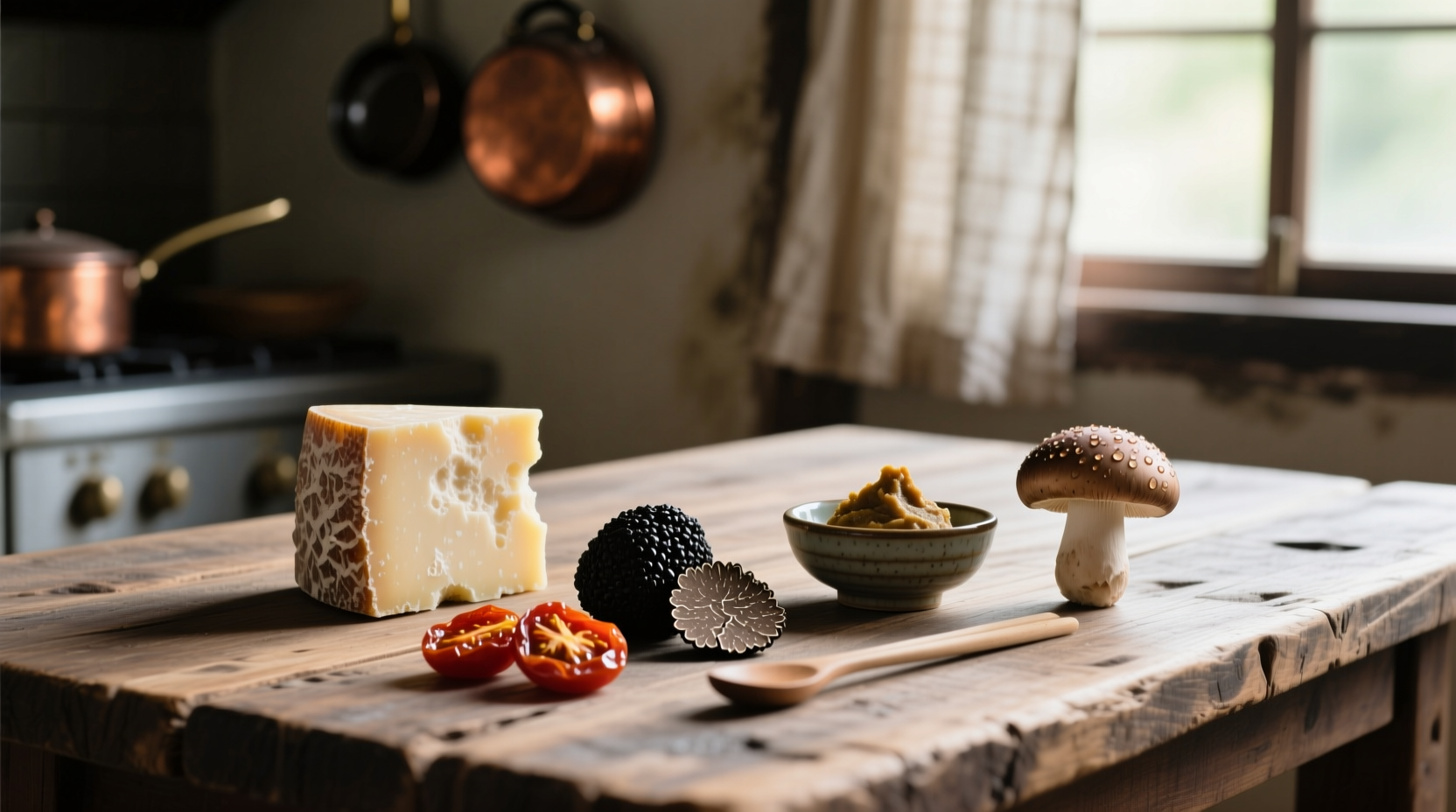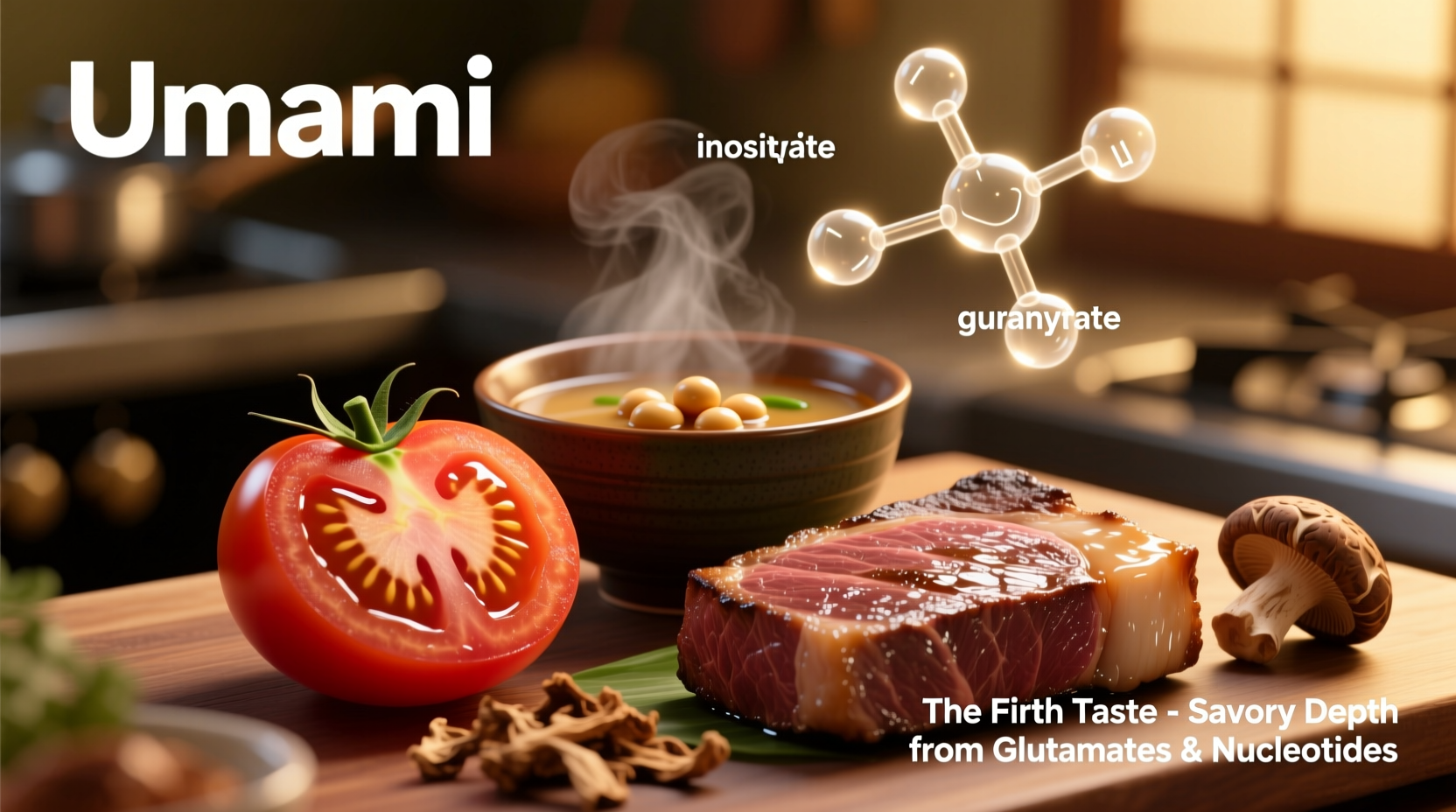Umami is the fifth basic taste sensation, scientifically recognized as distinct from sweet, sour, salty, and bitter. It's described as a savory, meaty, or brothy flavor primarily caused by glutamate and certain nucleotides found naturally in foods like tomatoes, mushrooms, aged cheeses, and soy sauce. First identified by Japanese scientist Dr. Kikunae Ikeda in 1908, umami enhances flavor complexity and creates a satisfying "mouthfeel" that makes food more appealing and palatable.
Ever wonder why a perfectly aged Parmesan cheese or a slow-simmered tomato sauce tastes so deeply satisfying? That's umami at work—the mysterious fifth taste that transforms ordinary ingredients into extraordinary culinary experiences. Understanding umami isn't just for professional chefs; it's the secret weapon that can elevate your everyday cooking from bland to brilliant.
The Science Behind Umami: More Than Just a Flavor
Umami isn't merely a taste—it's a physiological response. Our tongues contain specialized receptors (T1R1 and T1R3) that detect glutamate, an amino acid naturally present in many foods. When glutamate binds to these receptors, it triggers that distinctive savory sensation we recognize as umami.
What makes umami particularly fascinating is its synergistic effect. When foods containing glutamate (like tomatoes) are combined with foods rich in nucleotides (like mushrooms), the umami sensation multiplies—sometimes by as much as eight times. This scientific phenomenon explains why certain food pairings (think tomato sauce with mushrooms) create such profound flavor depth.

Umami Timeline: From Ancient Practice to Scientific Recognition
While the term "umami" entered scientific vocabulary in the 20th century, humans have been harnessing its power for millennia through traditional food preparation methods. Consider this historical progression:
| Time Period | Umami Development | Key Insight |
|---|---|---|
| Ancient times | Natural fermentation of fish, soy, and grains | Traditional methods unknowingly maximized umami compounds |
| 1908 | Dr. Kikunae Ikeda isolates glutamate from kombu seaweed | First scientific identification of umami as distinct taste |
| 1985 | International Umami Committee formally recognizes umami | Global scientific community accepts fifth basic taste |
| 2000 | University of Miami identifies umami taste receptors | Biological basis for umami confirmed through receptor research |
Natural Umami Sources in Your Kitchen
You likely already have umami powerhouses in your pantry. Unlike artificial flavor enhancers, these ingredients deliver complex savory notes through natural biochemical processes:
| Food Category | Top Umami-Rich Examples | Glutamate Content (per 100g) |
|---|---|---|
| Fermented Products | Aged Parmesan, Miso paste, Soy sauce | 1200-1680mg |
| Vegetables | Ripe tomatoes, Shiitake mushrooms, Seaweed | 140-180mg |
| Meats & Fish | Dried bonito flakes, Cured ham, Anchovies | 220-1000mg |
| Processed Foods | Ketchup, Worcestershire sauce, Tomato paste | 100-250mg |
Notice how cooking methods dramatically affect umami levels. Drying, aging, and fermentation all increase free glutamate content. A fresh tomato contains about 140mg of glutamate per 100g, but when processed into tomato paste, that concentration jumps to 250mg. Similarly, fresh shiitake mushrooms transform during drying as enzymes break down proteins into free glutamate.
Practical Umami Enhancement Techniques
Transform your cooking with these chef-approved umami-boosting strategies that require no special ingredients:
1. The Layering Principle
Professional kitchens build umami in layers. Start with a base of onions and garlic (which contain natural glutamates), add tomatoes or mushrooms, then finish with a sprinkle of Parmesan or nutritional yeast. Each layer contributes different umami compounds that work synergistically.
2. The Maillard Reaction Maximization
Browning isn't just about color—it creates new umami compounds through the Maillard reaction. When searing meats or roasting vegetables, resist the urge to stir too frequently. Allow proper browning time (about 3-5 minutes per side) to develop those complex savory flavors.
3. Strategic Ingredient Pairing
Combine ingredients from different umami categories for maximum effect. The classic Japanese dashi broth combines kombu seaweed (glutamate source) with dried bonito flakes (nucleotide source), creating a synergy that multiplies the umami sensation. Try these accessible pairings:
- Tomato sauce + Parmesan cheese
- Mushroom risotto + soy sauce
- Bean soup + kombu seaweed
- Grilled cheese + tomato jam
Debunking Common Umami Misconceptions
Despite its scientific validation, umami remains surrounded by myths. Let's clarify some persistent misconceptions with evidence-based information:
"Umami is just MSG"
This is perhaps the most widespread misunderstanding. While monosodium glutamate (MSG) does deliver umami, it represents just one way to experience this taste. Natural umami occurs in thousands of foods through free glutamate. The American Chemical Society confirms that the glutamate in MSG is chemically identical to the glutamate in tomatoes and cheese—the body processes both forms identically.
"MSG is unhealthy"
Multiple comprehensive studies, including those by the FDA and European Food Safety Authority, have concluded that MSG is safe for the general population at customary consumption levels. The so-called "Chinese Restaurant Syndrome" has never been scientifically substantiated in double-blind studies. Most reported symptoms appear to be psychosomatic rather than physiological reactions.
"Umami is only in Asian foods"
While Japanese scientists formally identified umami, the phenomenon exists globally. Italian cuisine relies heavily on umami through aged cheeses and tomato sauces. French cooking uses umami-rich demi-glace and mushroom duxelles. Even traditional American comfort foods like slow-cooked stews and barbecue benefit from umami development through the Maillard reaction and slow cooking.
When Umami Enhancement Fails: Practical Limitations
Understanding umami's boundaries prevents culinary mishaps. Consider these contextual limitations:
- Acid interference: High acidity can mask umami perception. Balance lemon juice or vinegar carefully in umami-rich dishes.
- Temperature sensitivity: Umami perception peaks around body temperature (98.6°F/37°C). Serve umami-rich soups and stews slightly warmer than typical serving temperatures.
- Salt requirement: Umami compounds require some sodium to activate taste receptors effectively. Completely salt-free umami dishes often fall flat.
- Overpowering risk: Too much umami creates a one-dimensional, almost metallic taste. Balance with other basic tastes for complexity.
Mastering umami isn't about adding more—it's about understanding how to work with this fundamental taste to create dishes with remarkable depth and satisfaction. By recognizing natural umami sources and applying strategic enhancement techniques, you'll discover how to make your cooking more flavorful without relying on excessive salt or artificial additives.











 浙公网安备
33010002000092号
浙公网安备
33010002000092号 浙B2-20120091-4
浙B2-20120091-4